With all this talk of portraits, I thought it would be a good time to look a little more closely at the paintings that exist that claim to be Anne Boleyn.
According to Eric Ives ‘there are two patterns which clearly represent separate traditions’ (Pg. 42).
On the one hand we have the pattern depicting Anne wearing a gable hood. A painting in this pattern is now in a private collection in Bradford and shows Anne wearing a gable hood and a brooch in the form of a single drop pearl hanging from the monogram ‘AB’.
On the other hand we have the pattern we most commonly associate with Anne today and that is Anne in a French hood with a gold letter ‘B’ hanging from a pearl necklace. Several examples of this alternative pattern survive. One of the best known is the portrait we are all trying so hard to save – the National Portrait Gallery Anne Boleyn.
Another well-known example of this pattern is the Hever Castle portrait although the features in this portrait are sharper than those of the NPG portrait.
Unfortunately, neither of these popular images is contemporary and so cannot be regarded as authoritative. Eric Ives states that the NPG/Hever pattern is not ‘linked to the portrait medal, either directly or via a common ancestor’ he goes on to say that the Hever/NPG pattern lacks the portrait medal’s ‘striking lift of the head’ (Pg. 42).
Why are we comparing these portraits to Anne’s 1534 portrait medal? Simply because it is the only surviving contemporary likeness of Anne that we have and although it is badly damaged you can still make out the long oval face and high cheek bones.
The medal was struck in 1534 and carries her motto, ‘The Moost Happi’ and the initials ‘A.R’ – Anna Regina. It was initially thought to have been struck to mark Anne’s coronation but the date makes this impossible. Ives believes that the more likely occasion was the expected birth of Anne’s second child in the autumn of 1534. Her miscarrying would explain why multiple copies do not survive (Pg. 42).
Ives believes that the key to finding the real Anne lies in an Elizabethan ring belonging to the Trustees of Chequers (Pg. 42).
“The ring itself is mother-of-pearl, the shank is set with rubies and the bezel carries the monogram ‘E’ in diamonds. It was previously in the possession of the Home family, having, it is said, been given from the English royal treasures by James I to the then Lord Home. The head of the ring is hinged and opens to reveal two enamel portraits, one of Elizabeth circa 1575 and one of a woman in the costume of Henry VIII’s reign, wearing a French hood.” (Ives, Pg. 42)
The ring itself is only small measuring 17.5mm across but it is clear to me that the sitter is the same person as the NPG/Hever pattern. In addition, who else, if not Anne could this woman be? It makes perfect sense that Elizabeth would cherish her mother in such a way.
The other important factor to consider is that the Chequers ring was made circa 1575, which means that it must have been accepted as an accurate likeness of Anne. Although Elizabeth couldn’t have remembered her mother, others in her court certainly would have.
To piece together the puzzle we must compare the chequers ring to the 1534 medal. The headdresses are obviously different, an English gable hood in the medal and a French hood in the ring.
Apart from this the sitter looks to be the same woman; ‘long oval face, high cheek-bones, strong nose and a decided chin’ as Eric Ives puts it: ‘a face of character, not beauty’ (Pg. 43).
And so the pieces are beginning to fall into place: 1534 medal, the Chequers enamel the Hever/NPG pattern- we are close to the real Anne Boleyn.
Another important portrait that fits this pattern is a 17th century miniature in the collection of the Duke of Buccleuch and Queensberry. Ives states that Charles I had this copied as ‘Anne Boleyn’ by John Hoskins the elder (c.1590-1664/5) and it is endorsed ‘from an ancient original’ (Pg. 43).
But just how ancient are we talking? The pattern is obviously the same as the NPG/Hever portraits. The sitter wears a French hood, with a golden letter B hanging from a pearl necklace, the face is long and oval, the cheekbones high and the nose strong.
Ives believes it’s likely that John Hoskins had access to an earlier image of Anne of the kind from which the NPG portrait originated.
Interestingly, a full-length portrait of Anne was owned by Lord Lumley in 1590 and existed as late as 1773! (Ives, Pg. 43). Where is this portrait today? Has it been painted over? Cut down? Destroyed? Unfortunately its fate remains a mystery.
There is some speculation that the Hoskins’ source was derived from a Holbein painting now lost (Ives, Pg. 43). Although this is just ‘speculation’ as no portrait of Anne by Holbein is known to have been made.
There are of course two of Holbein’s drawings that claim to be Anne. The first is in a set of his drawings in the royal collection at Windsor and the other now in the British Museum.

Unknown Lady, by Hans Holbein the younger, inscribed Anne Bullen decollata fuit Londini 19 May 1536. British Museum
The Windsor drawing is inscribed ‘Anna Bollein Queen’, in eighteenth century lettering and the other ‘in a hand dating from the first half of the seventeenth century, has the legend: ‘Anne Bullen was beheaded, London 19 May, 1536’ (Ives, Pg. 41).
The story goes that the name on the Windsor drawings derived from Sir John Cheke, Edward VI’s tutor, and since he knew Anne, this gives the portrait some authority. Though Ives states that this story is ‘suspect’ because several of Cheke’s supposed identifications have turned out to be incorrect. Furthermore, there is some evidence linking the Windsor drawing with the Wyatt family.
The other issue with the Windsor drawing is that the sitter does not appear to be fully dressed so why would Henry or Anne have commissioned such a likeness of a Queen?
Ives points out that when both of Holbein’s drawings were in the collection of the earl of Arundel in the late 1630s, the Czech artist, Wenceslaus Hollar, engraved the British Museum drawing in preference to the Windsor drawing.
Although it’s impossible to say why Hollar selected this particular drawing as a likeness to Anne it could have been because he had some advice on the matter or as Ives speculates, the Windsor drawing may not have even been labelled ‘Anne’ yet.
In my very humble and non-expert opinion, the sitter in the Windsor Holbein drawing bears a striking resemblance to the NPG/Hever, chequers ring, medal, and Hoskins pattern. When I put the Windsor drawing and the Hoskins miniature side by side, I see the same person. The sitter in the drawing is a little heavier but is it not possible that Anne might have been pregnant at the time of the drawing?
I must though point out that this is purely my opinion, Ives adamantly states that ‘judged by the medal, Anne sat for neither of the Holbein drawings’ (Pg. 42).
Therefore, in the words of Eric Ives: ‘Portrait medal – chequers ring – Hever/NPG pattern – Hoskins miniature: the chain is complete. We have the real Anne Boleyn (Pg. 43).
So what paintings do not fit the pattern? A portrait miniature assigned to the Flemish artist Lucas Horenbolte. The sitter looks very unlike the subject of the Chequers ring.
What do you think?
References:
Ives, E. The Life and Death of Anne Boleyn, 2004.
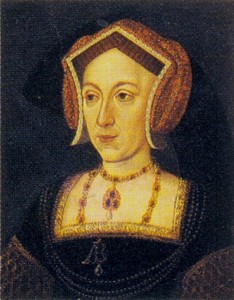
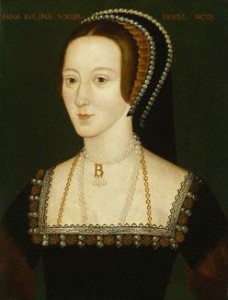
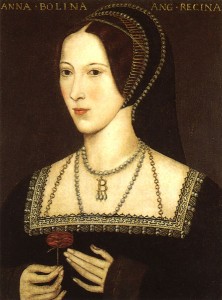
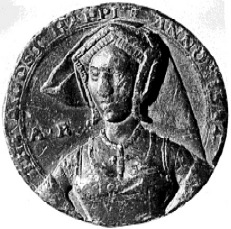

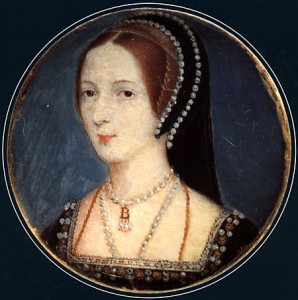



















I also think that comparing portait images of Anne to known period portraits of her daughter Elizabeth also help capture a sense of the woman. In my opinion, other that her hair color, there is very little of Henry evident in Elizabeth and I like to think that she bears a close resemblance to her mother! I’ve always wondered too if that resemblance bothered Henry just a bit…
I too Anne, like to think that Elizabeth looked like her mother and yes, you imagine that it would have been difficult for Henry to forget Anne!
I agree with Eric Ives. I can’t believe that Anne Boleyn would have been caught dead in a gabled hood! Although there is a portrait at Hever Castle that has her wearing one.
She is wearing a gable hood in the medal, the only contemporary liking we have. I imagine this was to show the people how ‘English’ she was. I much prefer her in the French hood!
Holbein was one of the greatest artists of his time, one who would have known Anne personally and seen her regularly at court – so the two drawings by him are the most worthy of consideration. The other full portraits are pretty much stylized and based on other works that are lost. Of the two drawings by Holbein, one has to say that given everything we know of AB’s character, it is inconceivable that she would have sanctioned or allowed such an unflattering image as the Windsor portrait to have got any further than the door of her chamber after its completion. The other, however, shows an attractive, spirited and astute young woman – just the woman that Henry would have fallen in love with. For me, therefore, and this is just a very personal opinion, there is really no question as to which is the most likely to be authentic: The British Museum Holbein. And that, really, by a mile.
I agree with what you are saying Robert but who would the great Holbein have drawn is such a state? What if it had been meant as a private memento? Or a private commemoration of a special moment – a pregnancy perhaps? I don’t know but I find the woman in the Windsor drawing intriguing. Her eyes are mysterious with a touch of sadness. Who is she???? Would make an interesting protagonist for a novel!
the real Anne IS the Holbein sketch at the British museum. I’ve looked at, probably 100’s of historic portraits and never had such a knee jerk reaction to one as i’ve had to this portrait of Anne. I almost jumped out of my chair, my recognition of her was instant — “that’s her.” I can’t convince another person, but i am completely convinced. Also, like you, Robert, this version of Anne perfectly fits the “spitrited, attractive, intelligent” descriptions we’ve read about her. I have no trouble at all picturing Henry going for this very interesting (and pretty !!) face. I am still thrown by the headband/ hairline debate, though….. i’m not sure if the dark line IS her hair or just part of the head-gear (??). I will continue to think of her as having blackish hair since there are some descriptions of her hair and eyebrows being like that.
I’d like to humbly submit that the Windsor portrait may be Catherine Brandon, Duchess of Suffolk. There is a strong resemblance, in my humble opinion, between this lady and the portrait of the Duchess: http://upload.wikimedia.org/wikipedia/commons/thumb/9/9c/Catherine%2C_Duchess_of_Suffolk_by_Hans_Holbein_the_Younger.jpg/432px-Catherine%2C_Duchess_of_Suffolk_by_Hans_Holbein_the_Younger.jpg
I believe your humble submission to be correct. The portrait does indeed appear to be another angle to Catherine Brandon. Well done!
Now that I’ve seen it, I agree too!
I agree with Mellisa – that really is a very close resemblance. It convinces me even more that the Windsor one is not AB.
When all is said and done, we would probably agree that they are all rather lovely. Thank you, Natalie, for supplying such a clear summary of all the available works. It’s good to have everything in one place like this.
Thank you Robert! The more I stare at all the portraits the more everyone looks the same! I have all of Holbein’s drawings in one book and love looking at them. Another Tudor mystery I suppose??
Really, no, when you study them both very closely. Eyebrows and nose are different……just the feel of the face, different. it’s all pretty tricky when you consider that i looked through about a dozen Tudor portraits just today and found that soooo many of these people honestly look just like one another……i’m thinking big inbreeding problem there…. just sayin. I am not swayed, anyway, the British museum Holbein IS Anne boleyn. I’m sorry she’s not around, she’d tell you !!
Great article Natalie. I was lucky enough to see the Anne Boleyn medal and gable hood portrait at the ‘Henry’s Women’ exhibition at Hampton Court in 2009 and the Lucas Horenbout at the V&A ‘Horace Walpole’ exhibition last year.
Thanks Tamise! So much to think about isn’t there! I saw the Holbein sketches at Windsor in 2009, so nice to see them in the ‘flesh’.
I wonder if anyone has seen the enigmatic portrait of Anne at Hever Castle? Not the famous one of Anne holding a rose but a different one, hung in Anne’s bedroom.
I have been doing some research on Anne and have come up blanks with this one. It is not mentioned or printed in any books I have read, nor have I found a copy on the internet – however I have a postcard, which I will upload as soon as I have scanned it in, if anyone is interested.
It depicts Anne, dated c. 1534, in the same outfit as the famous Hever and NPG portraits. Her hair is slightly lighter, more a chestnut brown than black, and her eyes a deep brown. She has her famous B necklace and another string of pearls, plus a gold chain as in so many portraits. If this is, as it is stated, genuinely c. 1534, it might be our first, and most accurate, portrait of Anne.
It’s a bit of a mystery to me, so if anyone can shed any light on the matter, I’d be very grateful.
Tiula, I do know the portrait you mean – it is lovely! Not sure if you have the Hever Castle guidebook but it has a large copy of it on page 23. The caption states, ’16th century portrait of Anne Boleyn entitled Regina Anglie 1534 (Queen of England), by an unknown artist, but probably the nearest likeness to Anne in the castle. She is wearing a black dress, encrusted with pearls and gold thread, and a matching headdress in the French style, together with her famous ‘B’ pendant.
Will look into this and see what else I can find
Thanks Don’t have guidebook but I’ll look into getting one. It just puzzled me as I would have thought it was a key source in working out what Anne looked like – seeing as the famous “twin” portraits are both late 16th cen – but have found nothing about it in books.
Don’t have guidebook but I’ll look into getting one. It just puzzled me as I would have thought it was a key source in working out what Anne looked like – seeing as the famous “twin” portraits are both late 16th cen – but have found nothing about it in books.
Great comments and analysis! I like Robert’s idea about the one Holbein one. I think Anne must have had some attractive features–and a couple of these really don’t. I do think Elizabeth resembled her mother–the dark eyes and long, slender face. They both had allure, obviously. Thanks!
Another clue in the Hever Castle portrait is the use of her hands, not seen in the others. Was this something that was “done” in that period, or much later? The fingers are long and slender, much like Elizabeth’s, whose hands were often depicted in portraits.
If only one could go back in time with a videocam!
In regards to the looks of Elizabeth l, she had her father’s hair color, and strongly resembled her grandfather, Henry Vll.
Appertaining only to the Chequers Enamel Ring and the description of its dimensions being, in part, “… small measuring 175mm across…”, and not to the likeness of Queen Anne, this must surely be a typographical error, as 175mm is equivalent nearly to 7 (~6.89) inches.
Thank you for pointing this out, Mark! Definitely a typo. The measurement was missing the decimal point… Would have been a very large ring otherwise!
In the Windsor portrait, just below the woman’s hood there appears to be hair not a ribbon as in some portraits, and her hair appears to be blond. Wasn’t Anne’s hair dark brown or black?
Elizabeth I was almost a carbon copy of her maternal grandmother, Elizabeth Howard.
I made my previous comment based on an image I found online that was labelled Elizabeth Howard, however, upon more inspection, I think it may actually be Elizabeth 1 herself based on the clothing – a large lace ruff more in the style of the 1600’s … so, maybe not a carbon copy of her grandmother after all
Could some of the portraits be Mary Boleyn? That would give a general family resemblance to the features, but perhaps a different hair color, and possibly different tastes in hoods (gable vs. French).